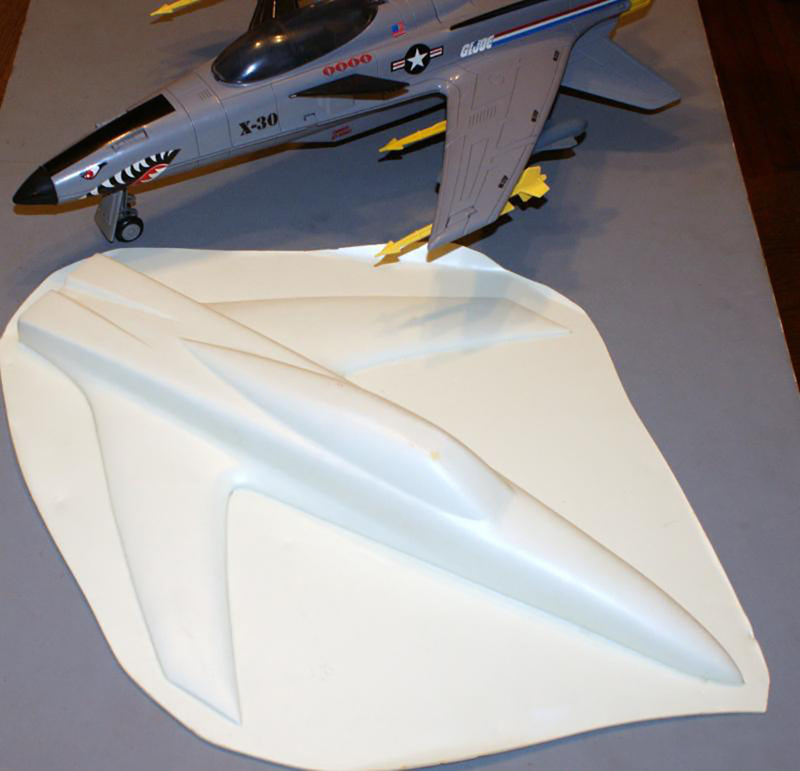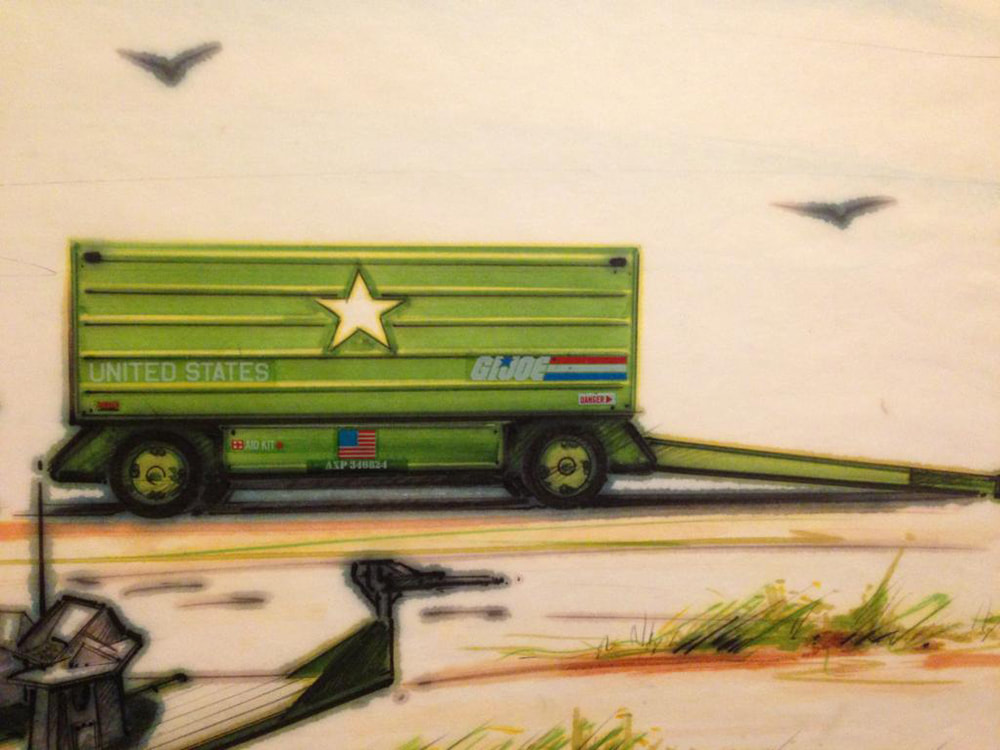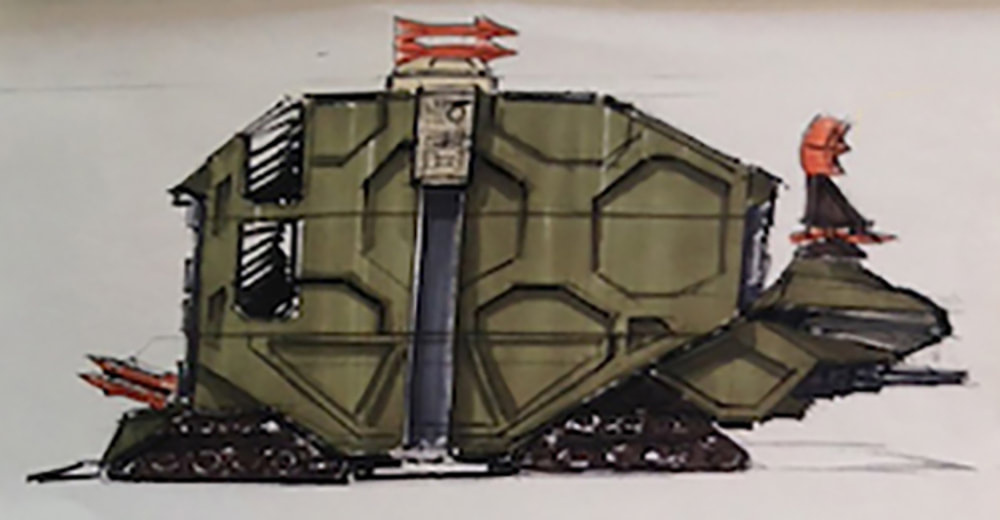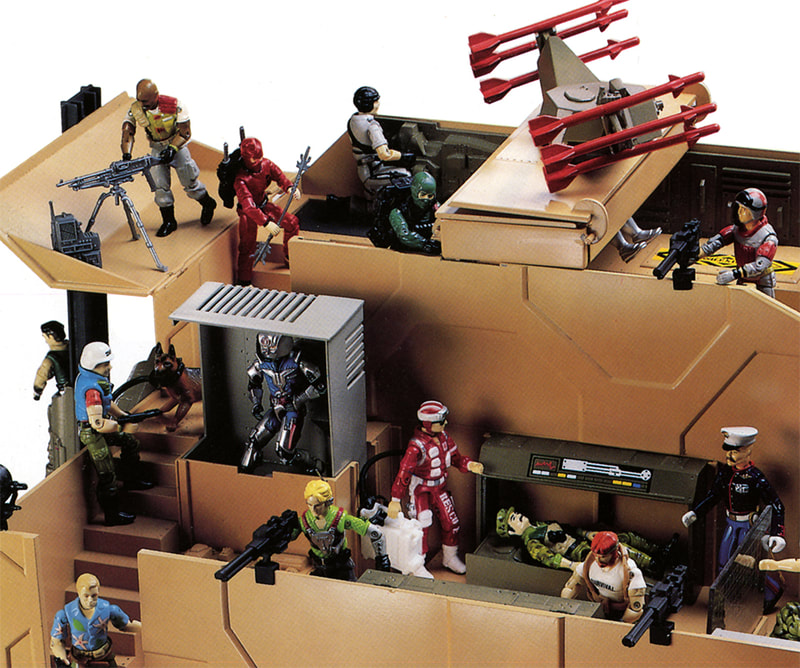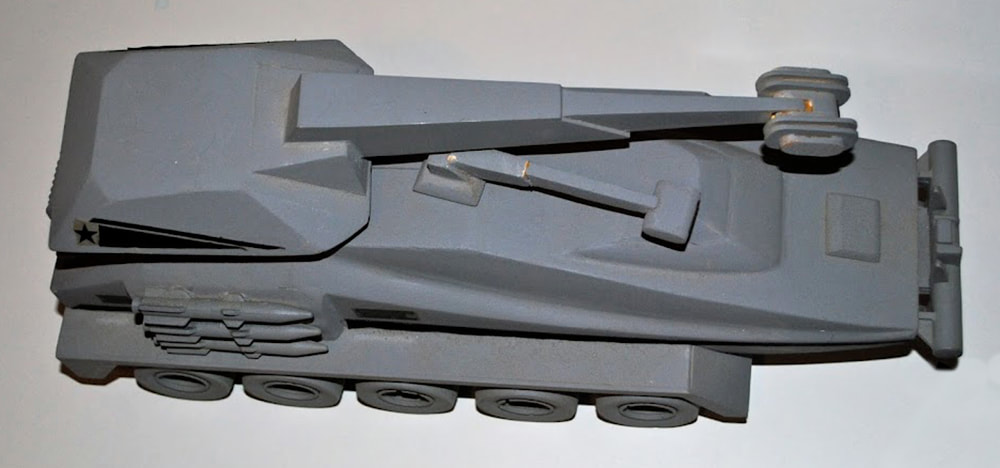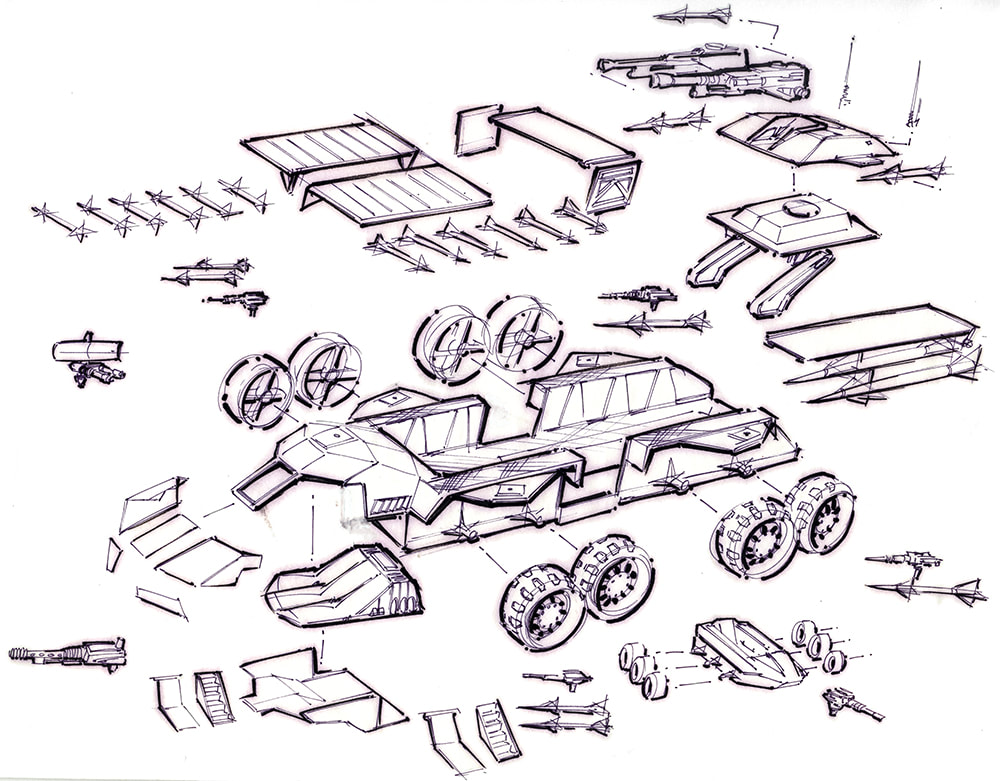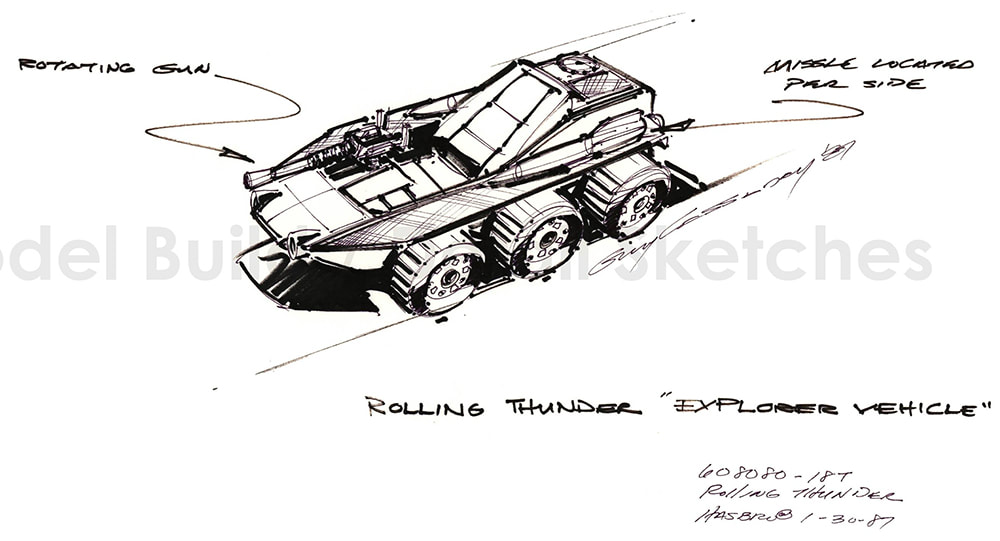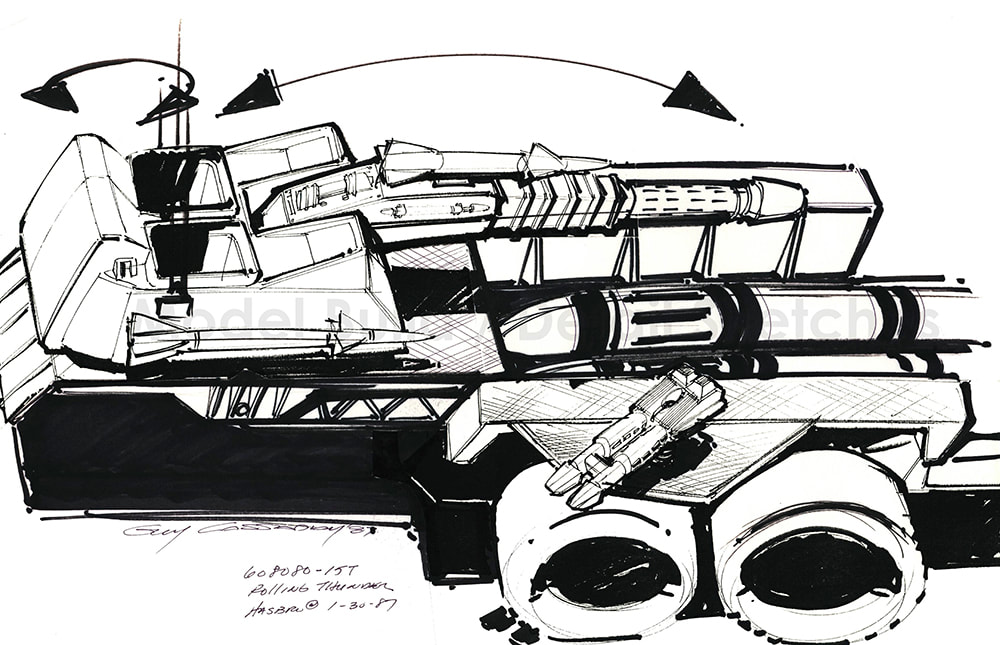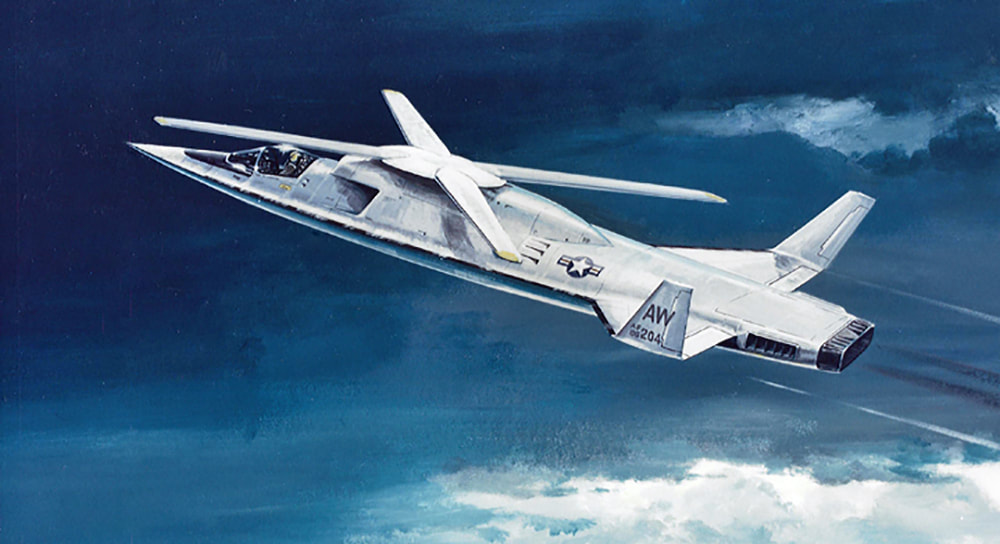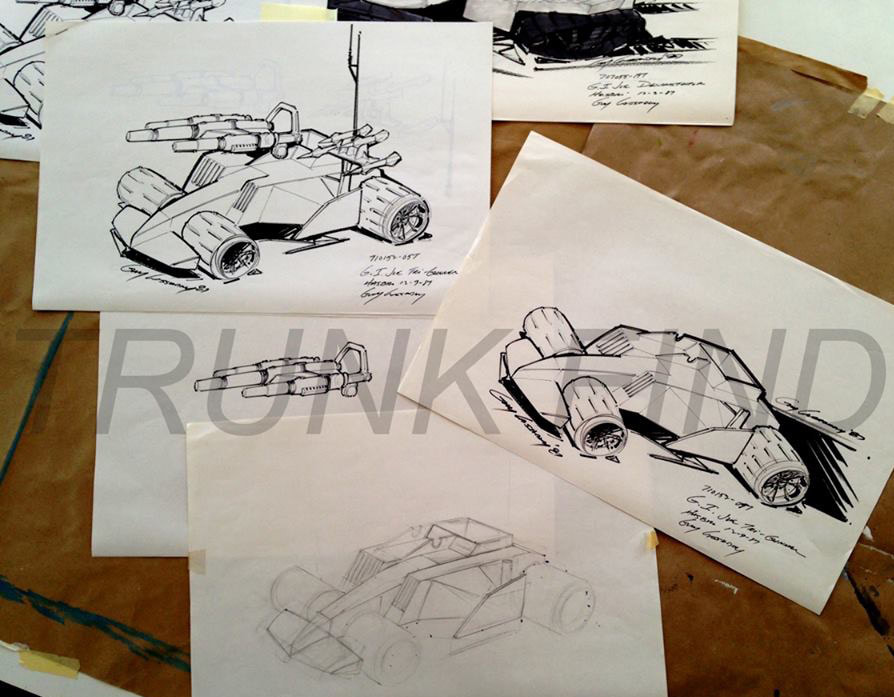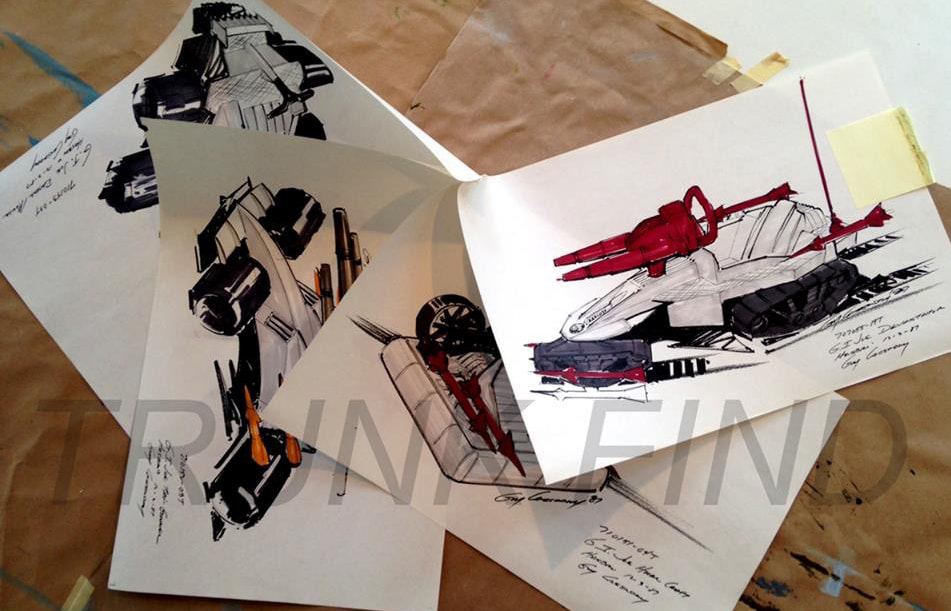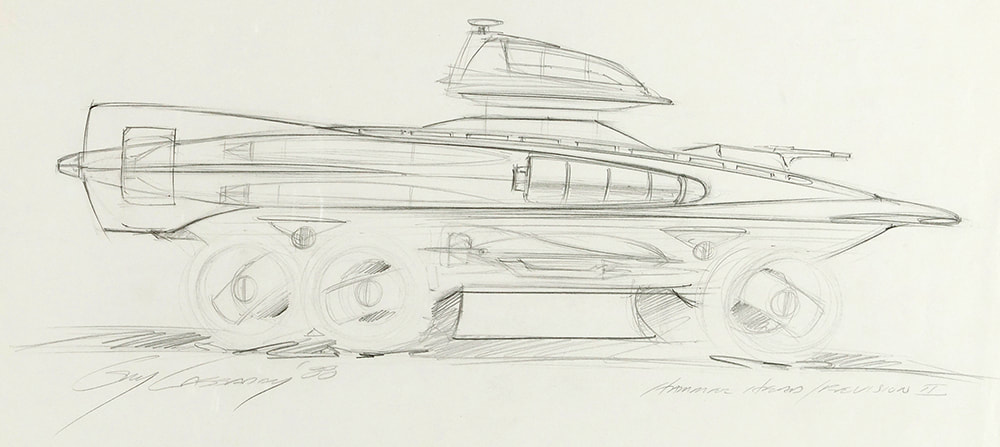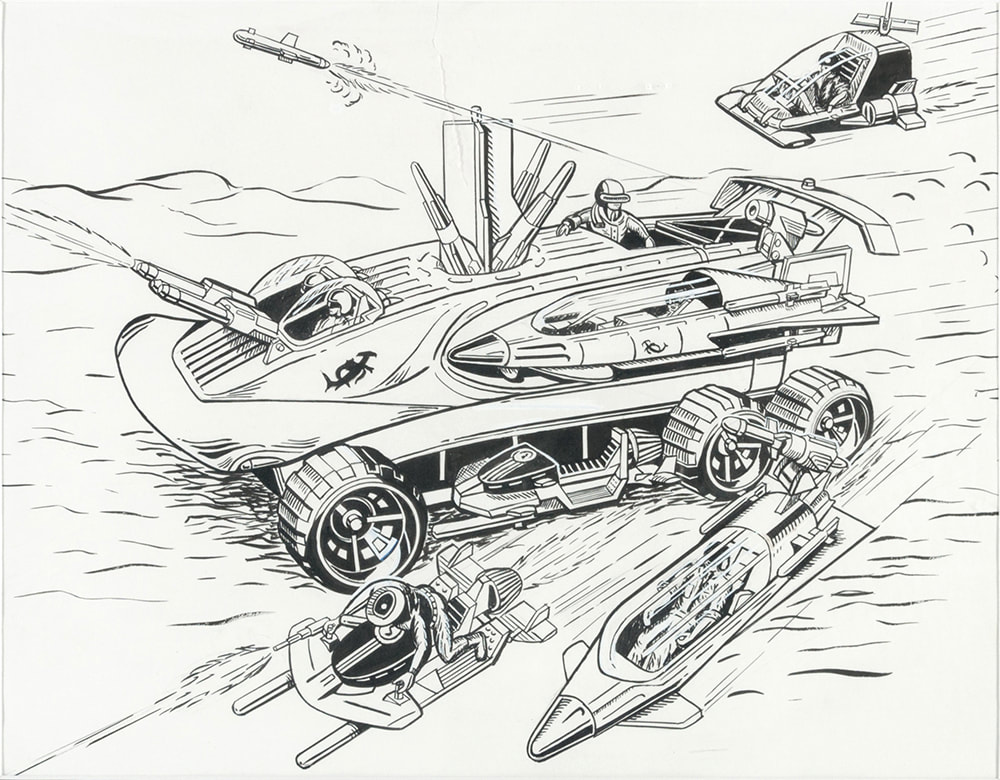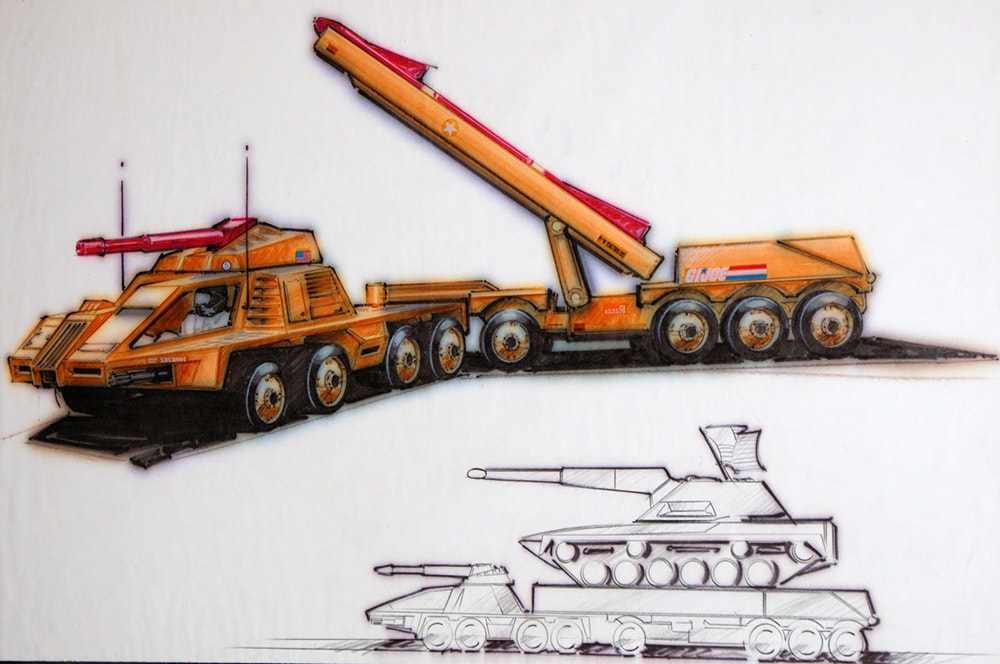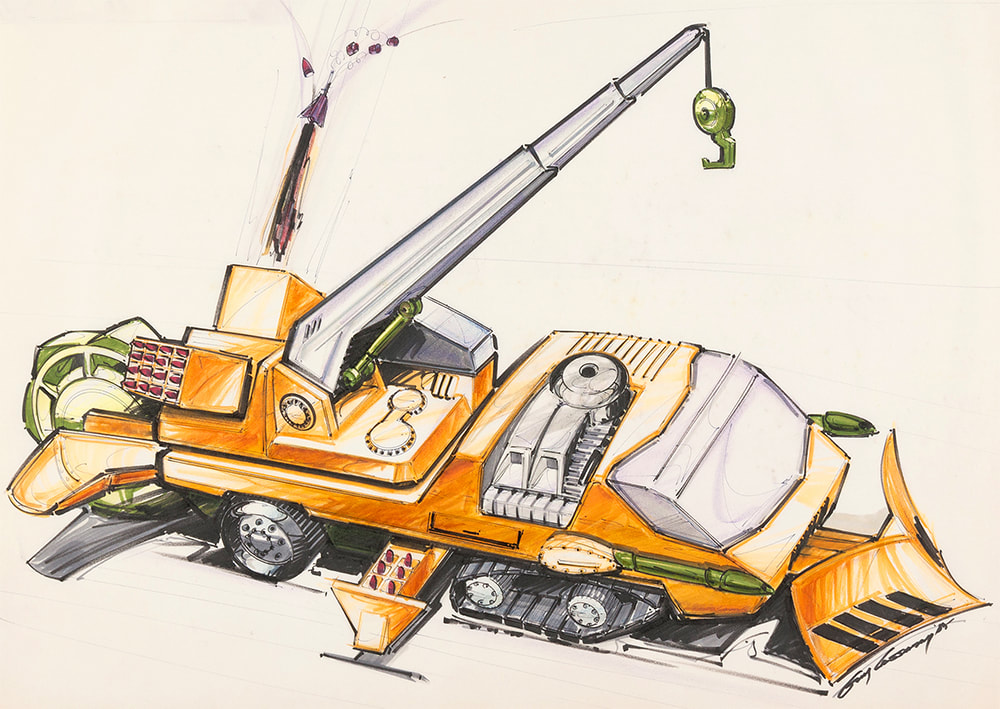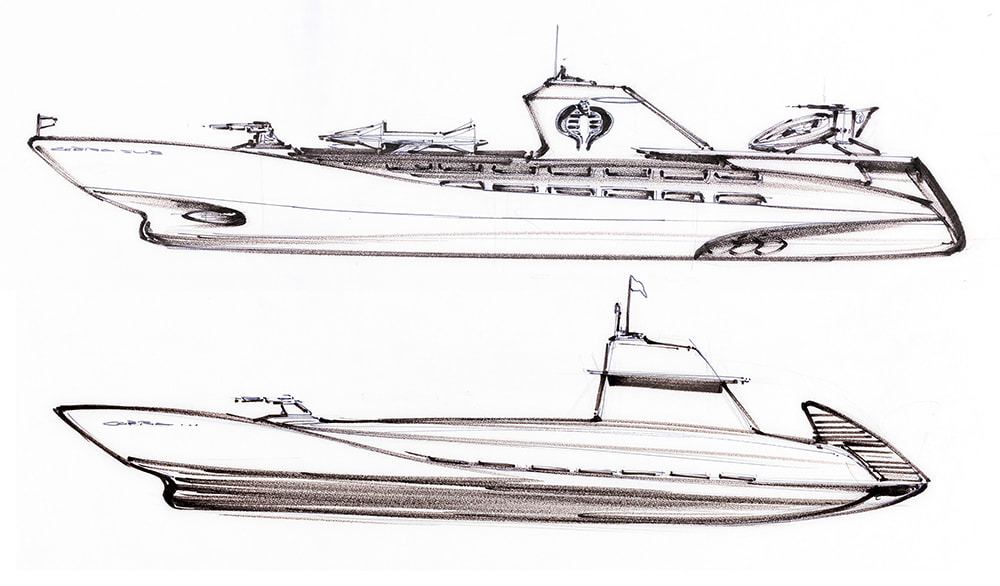Creator Profile: Guy Cassaday
Guy Cassaday was one of Hasbro's most productive vehicle designers. He worked on G.I. Joe: A Real American Hero's from 1985-1990. The 1986 Conquest X-30 was his first vehicle, and he soon went on to be labeled "The King of the big vehicles" after designing the 1987 Mobile Command Center. This name stuck, and he went on to design the 1988 Rolling Thunder, the 1990 Hammerhead, and the 1990 The General. He didn't just design big vehicles though, he also designed Serpentor's Air Chariot, the Dreadnok Swampfire, the Coastal Defender, the Persuader, the Skystorm, all four 1989 Battlefield Robots, and more. Some of his canceled designs have also generated tremendous buzz in the community, such as the Cobra Sub and the Cobra Island playset. Read on to learn about his impressive contributions to the brand.
But first, some thanks.
This Creator Profile was created by Carson Mataxis and Chris Murray. We would like to thank Guy Cassaday, Kevin Watts, Page and Greg Wagner, and David Gildersleeve for their contributions. All 3D photos, traditional photos, scans, videos and audio files are used with permission and ©2012-2023 3DJoes. All Rights Reserved. No usage is permitted without written permission.
From Art School to A Real American Hero
|
Guy Cassaday graduated from Art Center College of Design with a B.S. majoring in Transportation Design in 1980. He was then hired by Tonka Corporation. While at Tonka he helped redesign the iconic Yellow Tonka Mighty Dump Truck and many other construction vehicles. He was thrilled to tap into his love of vehicle design to the toy industry.
A brief stint at Playskool in Chicago, led to a career at Hasbro, Inc. Playskool (a subsidiary of Milton Bradley); was acquired by Hasbro, Inc. in 1984. Soon, Guy Cassaday would join the G.I.Joe team. |
A Designer's Life, at Hasbro in the mid-1980s
Guy's career at Hasbro spanned 14 years, from August 1983 to June 1997. This including stints at Playschool in Chicago and with Tonka. Playskool was acquired by Hasbro in 1984, and The Tonka Corporation was acquired by Hasbro in 1991.
Guy started working on G.I. Joe in 1985 as a vehicle designer. During his first few years on the brand, he did it all: from conceptualization, to ideation, refinement, color studies, presentation illustrations, exploded views for cost input, and part breakdown illustrations. Designers in the mid-1980s were even tasked with building working models from scratch for replication.
Building these models usually began with forming the shape out of wood (referred to as a wood pattern). Then they would use a vacuform machine to pull heated styrene (a plastic more formally known as polystyrene) down over the wooden shapes. For some larger, more complex shapes they would drill holes in the wood patterns to help facilitate the air coming through, which would help pull down the heated styrene down tightly over the wood pattern (Guy specifically recalled needing to drill holes in the Conquest X-30 and Persuader wood patterns).
From here they could cut the styrene pieces and begin assembling their model. Once they had a working model that they were happy with, they turned it over to the model shop for slight adjustments and then duplicates were created for Toy Fair, for sales samples, and for engineering.
The Skystorm was the last model Guy would build at Hasbro. Going forward, designers would submit very tight control drawings to the model shop and they would handle all fabrication.
Guy started working on G.I. Joe in 1985 as a vehicle designer. During his first few years on the brand, he did it all: from conceptualization, to ideation, refinement, color studies, presentation illustrations, exploded views for cost input, and part breakdown illustrations. Designers in the mid-1980s were even tasked with building working models from scratch for replication.
Building these models usually began with forming the shape out of wood (referred to as a wood pattern). Then they would use a vacuform machine to pull heated styrene (a plastic more formally known as polystyrene) down over the wooden shapes. For some larger, more complex shapes they would drill holes in the wood patterns to help facilitate the air coming through, which would help pull down the heated styrene down tightly over the wood pattern (Guy specifically recalled needing to drill holes in the Conquest X-30 and Persuader wood patterns).
From here they could cut the styrene pieces and begin assembling their model. Once they had a working model that they were happy with, they turned it over to the model shop for slight adjustments and then duplicates were created for Toy Fair, for sales samples, and for engineering.
The Skystorm was the last model Guy would build at Hasbro. Going forward, designers would submit very tight control drawings to the model shop and they would handle all fabrication.
Product Commentary (1986-1990)
1986 Conquest X-30
The 1986 Conquest X-30 was inspired by the Grumman X-29. Guy saw a tiny, black and white photo of the X-29 in Time or Newsweek and "that sparked the idea for me to create the X-30." The X-29 was an experimental American aircraft that tested forward-swept wings and canard control surfaces. The two Grumman built X-29s were flown by NASA and the United States Air Force from 1984 through 1991.
The image gallery below shows Guy Cassaday's early "X-26A" fighter jet illustrations. These pencil, pen and marker illustrations show the progression from loose, gestural drawings to tight line art that starts to consider the engineering challenges ahead. These illustrations show many ideas that were cost reduced out of the design, such as side fuselage lights, wing tip lights, variable sweep rear wings, and an arrestor hook for landing on the U.S.S. Flagg. The last two sheets show decal designs and include the insignia that would be used for the Conquest X-30. Roll over the images below to find out more, or click the images to enlarge them.
The Conquest X-30 was Guy Cassaday's first model build at Hasbro. He began by forming the shape out of wood. Then he used a vacuform machine to pull styrene down over the wooden shape. Then he cut the styrene pieces and began assembling the model. Once he had a working model that he was happy with, he turned it over to the model shop for slight adjustments. The model shop created duplicates for Toy Fair, for sales samples, and for engineering. Roll over the images below to find out more, or click the images to enlarge them.
|
Guy discusses where some details were lost in translation between design and engineering. He discusses the dynamic between designers and engineers at Hasbro in the mid- to late-1980s, and learning to get over these missteps.
|
1986 Air Chariot
The Air Chariot was initially conceived by Ron Rudat, Serpentor's figure designer. Management assigned the concept to Guy Cassaday to refine. Guy's early Air Chariot illustrations below were labeled "Cobra Emperor Imperial Hovercraft" and dated 7-16-85.
Guy gave the Air Chariot a more fluid design (whereas Ron's design was more hard edged), and he incorporated the Cobra head on the front. Guy hand built the model from styrene. The Polaroids below show Ron Rudat's presentation art, the foam costing model, and Guy with his painted model.
The numbers on the gun decals are an easter egg showing Guy's birthday, November 6th.
The Dreadnok Swampfire was a combination of different vehicles, since the Dreadnoks pilfered and combined different vehicles. The serrated edges of the helicopter blades were intended to be used to hack through reeds or opponents. The image gallery below shows Guy Cassaday's early "Dreadnok Swampcraft" illustrations. These pencil, pen and marker illustrations show the progression from loose, gestural drawings to tight line art that starts to consider the engineering challenges ahead. The three sheets show color breakdown, an exploded view, and decal placement. Roll over the images below to find out more, or click the images to enlarge them.
|
|
Guy Cassaday built the Dreadnok Swampfire model from scratch. The color-change (photochromic) plastic stunk. The pontoons were sonic welded (to avoid water leaking in and causing mold), and they smelled “like a toxic waste plant.” The smell was so bad they added vanilla extract to the plastic. Roll over the images below to find out more, or click the images to enlarge them.
1987 Battle Force 2000 (all six vehicles)
|
The initial Battle Force 2000 design featured a base that all of the detachable vehicle components would attach to, making a more robust Future Fortress. Unfortunately "that went out the window" due to marketing not finding a path to profitability. They couldn't figure out how to package and sell the main base component. In Guy's view, "it was all about cost and making money." He even went on to lament: "Sorry all, I did my best." Guy went on to create a layout of all the detachable vehicle components to make the now infamous "V" shaped Future Fortress.
|
Guy Cassaday discusses the initial concept for the Battle Force 2000, and how that evolved (or devolved) due to cost reductions. He also describes the six vehicles and their dual functionality. |
The Vector jet was created by another designer and Guy was tasked with refining it. Below are images of the styrene model for the Vector jet. Many details on this model were changed to create the final product, including the jets, engine intake, and length of the fuselage. Guy recalled revising this design to make the fuselage blend more seamlessly with the rotating rear turret. Click the images below to enlarge them.
The 1987 Battle Force 2000 vehicles were not featured in the 1987 Toy Fair catalog. The photos below are from the 1988 Toy Fair catalog. Roll over the images below to find out more, or click the images to enlarge them.
|
|
Vehicle concepts often go through many iterations. Roll over the images below to find out more, or click the images to enlarge them.
The presentation art shown below was drawn by Guy Cassaday on Vincent Vellum. Vellum gives artists the flexibility to draw and paint on both sides of the page, which allows for muted background colors to show through behind the more saturated art on the front of the page. This technique is popular with automotive designers. This presentation art shows a more sizable Coastal Defender, before being cost reduced down to the smaller vehicle we received. Click the images to enlarge them.
Below are two Polaroids showing the Coastal Defender prototype, hand made by Guy Cassaday.
1987 Crossfire: Radio Control Fast Attack Vehicle
1987 Defiant: Space Vehicle Launch ComplexKirk Bozigian (Product Manager) and Guy Cassaday (Vehicle Designer) discuss the Defiant summer of '86, when all hands were on deck to build this behemoth. Guy recalls designing the suspension and tires, and there eventual performance under the weight of the set: "It was not good!"
The 1987 Defiant: Space Vehicle Launch Complex made its debut in the 1987 Toy Fair catalog, seen right. |
1987 Mobile Command Center
|
Below, Guy discusses the normal two year production timeline for a G.I.Joe vehicle or playset, and why the Mobile Command Center took three years. Guy recalls the model build as extremely challenging, taking 12 weeks. Frank Coroneos came onboard toward the end of the design phase and helped finish off the accessories. Guy recalls "It was too big for one person." He also reveals some easter eggs on the decals.
|
Kirk Bozigian recalled when Bob Prupis was the head of boys toys marketing: "He taught me the best business management technique is what he called "management by roaming around." He would always hang out in design looking over the designer's shoulders. One day Bob saw a design for the G.I. Joe Mobile Command Center and said it should be even bigger. The designer [Guy] turned to him and said "How? We are already in cost trouble." Bob said, "I don't know. Just add some air." So, the designer [Guy] turned it into a fish tackle box. Thus was born the expression Prupis Air." Guy Cassaday added "If I could add to your description... I thought he said "Just fill it with air” :-)"
|
The cost input drawing below was drawn by Guy, but it shows a British inventor's design. Guy was tasked with creating a toy from this idea. Note how the input drawing shows a telescoping driver's cabin, and the second illustration gives us a more detailed look at this idea. The British inventor whose idea was used to create the MCC received a royalty check from Hasbro. Guy's revised MCC design was influenced by the Jawas' Sandcrawler which first appeared in Star Wars: Episode IV - A New Hope in 1977. Roll over the images below to find out more, or click the images to enlarge them.
The illustrations below are called color studies. The designer would typically photocopy their black and white line art, and then quickly create 5-10 different color options using colored markers. They would then review these with management and pick a direction. Click the images to enlarge them.
The Polaroids below show the completed prototype, designed and developed by Guy Cassaday. The Persuader costing model was used for scale.
The art below was art created for a licensee to use on a non-toy product. Note the unreleased green color scheme.
The image below left shows a pre-production Mobile Command Center that appears to be dark green. We asked Guy about this photo. Guy recalled that he "pushed for the color tan, as you might see in Desert combat scenario." Guy recalled that the gentleman on the right worked in the model shop. "I enjoyed working with him." He also remembered Jeff Thompson as the gentleman in the red shirt and said he was "funny as heck." Jeff worked on Air Raiders, maybe Inhumanoids, and other boys designs." Image source: Tristan Rudat's Code Name: Blast Off trailer (seen below right).
The 1987 Mobile Command Center made its debut in the 1987 Toy Fair catalog, seen below. Click the images below to enlarge them.
1987 Persuader
|
Guy Cassaday (Vehicle Designer) discuss finding the inspiration for the Persuader, and how it was initially designed as a Cobra vehicle.
|
Guy Cassaday (Vehicle Designer) recalls the family history behind "Dead Eye" and working his last name into the decals.
|
|
One of the common themes from Guy's interview was the brutal reality of cost reduction. Designers would "shoot for the moon" during conceptualization and ideation, packing vehicles full of features. Below, the illustration on the left shows the original styling direction prior to cost reduction. There were working front and rear winches, nose mounted swivel guns, working spotlights, and antennas everywhere. Eventually they would refine these designs and create illustrated exploded views for cost input. Designers would work collaboratively with marketing and "the bean counters" (as Kirk Bozigian would put it), and they would determine what features would make the cut, and what had to hit the cutting room floor. Often, in addition to losing features, vehicles were scaled down. Roll over the images below to find out more, or click the images to enlarge them.
|
|
|
|
1988 Iron Grenadiers A.G.P. (Anti-Gravity Pod)Guy Cassaday (Vehicle Designer) discusses the inspiration for the 1988 AGP, and although the name is not mentioned, he appears to be describing Boba Fett's Slave I from Star Wars Episode V - The Empire Strikes Back.
|
The two ideation sketches and the two presentation art samples below all show different missile positions. Interestingly, the presentation art appears to show the rear of each missile attached to the front of the wing and nose of the A.G.P. We never saw this kind of missile mount throughout the ARAH line. Roll over the images below to find out more, or click the images to enlarge them.
The photos below show the hand built 6" tall, 3" wide, 9" long styrene A.G.P. prototype. This prototype was built by Bill Cooke, Sr. Industrial Designer at Hasbro from 1983-1994. Bill was an R&D engineer and was tasked with making working models. The prototype below features a working clear canopy, rotating guns, pivoting thrusters, swiveling rear rudder, and one detachable Sparrow missile. Building these models usually began with forming the necessary shapes out of wood, then using a vacuform machine to pull styrene down over the wooden shapes. From here they would cut the styrene pieces and assemble the model. This prototype shows one missile attached to the tip of the horizontal wing. By the time the A.G.P. reached production they mounted another on the top of each vertical stabilizer. When building prototypes, they would typically only fabricate one of each piece that would be duplicated: in this instance they only created one Sparrow missile. Roll over the images below to find out more, or click the images to enlarge them.
During Guy's first few years on the brand, he did it all: from conceptualization, to ideation, refinement, color studies, presentation illustrations, exploded views for cost input, and part breakdown illustrations. The photo gallery below shows Guy and his two part presentation art for the Desert Fox 6 W.D. Although this was created relatively far along in the development process, many changes were still in store for this concept. As the Desert Fox 6 W.D. moved toward production, the working spotlights and K-Resin® tinted glass windshield were cost reduced out of the design. Roll over the images below to find out more, or click the images to enlarge them.
The Desert Fox 6 W.D. made its debut in the 1988 Toy Fair catalog, seen below. Note the small antenna on top of the computer station. This was replaced by a larger antenna mounted on the rear bumper. The Desert Fox’s package art was based off of the prototype and features the smaller computer antenna. Click the images below to enlarge them.
1988 Rolling Thunder
|
Guy had just finished the Mobile Command Center, and was searching for inspiration for the next big G.I. Joe vehicle. He was stumped for weeks. In the audio clip below Guy discusses his inspiration for the Rolling Thunder: a Marine APC from the 1986 film, Aliens.
|
When asked what his favorite G.I. Joe product was, Guy picked the Rolling Thunder without hesitation. In the audio clip below Guy discusses the juxtaposition of moms protesting outside of Hasbro while he's developing a toy of mass destruction.
|
The ideation sketches below show the Rolling Thunder in early development. Many changes were still in store for this concept.
As the Rolling Thunder moved toward production, a double missile bay was developed, the two man deployable six-wheeled ATSV (all terrain scout vehicle) was downsized, an additional vehicle was cut and replaced with the “Turntable” magnetic array radar/multi-missile air defense, and many more. Roll over the images below to find out more, or click the images to enlarge them.
The exploded view below was created to show each part that would need to be manufactured, and this would help estimate costing. This design would still evolve significantly before moving into prototyping and eventually into production. Note the telescoping tilt-back turret, twin missiles, six missiles housed under each bay door, and cabin interior access ladder.
The refined Rolling Thunder development sketches below were provided by Guy Cassaday and more closely reflect the final product. Roll over the images below to find out more, or click the images to enlarge them.
The Polaroids below show the presentation art and costing model, all created by Guy Cassaday.
The Rolling Thunder prototype was built by engineers, but Guy did build the Rolling Thunder's ATSV (all terrain scout vehicle) shown below. This prototype featured two missiles that were cost reduced out of the final product. The Rolling Thunder is Guy's favorite vehicle that he designed.
The 1988 Rolling Thunder made its debut in the 1988 Toy Fair catalog, seen below. The Rolling Thunder was originally designed to include an interior access ladder that swung down from the cabin. This ladder was cost reduced out of the design before the vehicle went into production
|
Guy's 1988 G.I. Joe Skystorm X-Wing Chopper was inspired by an aircraft design that never actually flew – Sikorsky's X-Wing concept. This experimental aircraft has a long and complex history. The Rotor Systems Research Aircraft (RSRA) was developed by Sikorsky for NASA and the Army in the 1970s. It was a pure research aircraft "developed to fill the void between design analysis, wind tunnel testing, and flight results of rotor aircraft." [1] The RSRA project began in 1970 was airborne by 1976. In 1981, NASA and the Army solicited proposals for fitting a four-bladed main rotor to the RSRA. Sikorsky proposed fitting a UH-60A main rotor to the RSRA. The public roll-out of the RSRA/X-wing occurred on August 19, 1986 [2], even through the plane had never flown in this configuration. "The plan was to then fly it first with two rotor blades, followed by four blades, with the rotors stopped. By mid-1987 the RSRA was scheduled to fly with the rotor/wing turning at full speed, and by year’s end the rotor/wing was to be stopped and started in flight." The US Government laid waste to those plans in 1987, terminating the contract in favor of funding other higher priorities. Read much more here.
|
Guy's 1988 G.I. Joe Skystorm X-Wing Chopper was inspired by an aircraft design that never actually flew – Sikorsky's X-Wing concept. Roll over the images below to find out more, or click the images to enlarge them.
1989 Battle Force 2000 Pulverizer
1989 Battlefield Robots: Devastator, Hovercraft, Radar Rat, Tri-Blaster
All four Battlefield Robots were designed by Guy Cassaday. He optimized costs by utilizing the maroon gun, missiles, and whip antenna on both Cobra Battlefield Robots and the gray wheels, green whip antenna, missiles and missile rack on both G.I.Joe Battlefield Robots.
These Battlefield Robots development sketches were provided by Guy Cassaday. Click the images to enlarge them.
The "Robot Series" Polaroids below are signed by Guy Cassaday and dated 11-20-87.
The Advanced Group at Hasbro would produce ideas for products across the company. They presented a water-squirting concept vehicle that looked like the Hammerhead. The concept was shot down. Guy had seen the concept, thought it was cool, and wanted to resuscitate it as a Cobra submarine.
|
|
The Cobra Hammerhead went through many revisions. The first costing model shown below features two Rolling Thunder Lightning Rockets that rotate up from the rear. The second costing model shown below features a winged craft in place of these rockets. Next, we have conceptual line art signed by Guy Cassaday, dated '88, and labeled Hammer Head Revision II. Next we have presentation art signed by Guy Cassaday and dated 9-30-88. At this point in the Cobra Hammerhead's development Bill Young took over for Guy as he transitioned off of the brand. The prototype below was fabricated by Bill Young. Roll over the images below to find out more, or click the images to enlarge them.
The 1990 Cobra Hammerhead made its debut in the 1990 Toy Fair catalog, seen below.
|
|
|
The illustration below is signed by Guy Cassaday and dated 1985. The production General was much smaller than this initial "Rolling Thunder" concept, which featured 16 wheels and required the landing pads to be retracted to fit through a standard 36" doorway. Note the Mauler on the loading platform.
The Polaroids below show the costing model built by Guy Cassaday (Rolling Thunder used for scale).
Bill Young took over design duties at this point in the General's development, while Guy transitioned off of the brand.
The prototype below was fabricated by Bill Cooke.
The prototype below was fabricated by Bill Cooke.
The 1990 General made its debut in the 1990 Toy Fair catalog. The 1991 Toy Fair catalog is shown below. Roll over the images below to find out more, or click the images to enlarge them.
What Could Have Been:
G.I. Joe Armored Transport (1985)
This full color presentation art was mounted on a 21" x 29" board with with masking tape and was signed and dated 8-19-85 by Guy Cassaday. It shows the vehicle in two modes: first in full color as a tank transport/recovery vehicle, and second in black and white as a missile launch.
G.I. Joe C.R.A.B. (1985)
This presentation art was signed and dated 10-28-85 by Guy Cassaday. Guy recalled that this vehicle was loosely a Seabees concept. The Seabees nickname refers to The United States Naval Construction Battalions, using a heterograph of the first letters "C B" of Construction Battalion.
Cobra Sub (1986)
Guy discussed trying for years to sell through the concept of a Cobra Submarine. That's what motivated him to save the Advanced Team's pitch and turn it into the 1990 Cobra Hammerhead. The illustrations below show years of effort on Guy's behalf to sell through the concept of a Cobra Submarine.
Cobra Island (1986)
The Cobra Island concept was created by Guy Cassaday in 1986. This concept shows Mr. Cassaday's vision of how Cobra Island would look in toy form. He did not read the comic books and was not familiar with the designs used therein.
Guy created 30 sketches for costing and model building purposes. The 31st sketch (the first one shown below) was drawn in 2007 to demonstrate what the play set would have looked like closed. All sketches are black and white, and were created with black marker and fine pen. A color presentation rendering and a crude model were also created for this concept. The model was heavy and it did articulate/unfold as the sketches conveyed. Sadly, the presentation art and the model were lost years ago. These sketches are all that remain.
Cobra Island was styled to look like a barren rock mountaintop. It was a very large play environment that would have stood 24" high, and the diameter of the base in the closed position would have been about 24". The overall width of the playset in the unfolded position would have been around six feet!
There are five separate compartments or sides, each of which unfold to reveal the multilevel tower hidden inside. The compartments or stations are labeled in the fourth sketch seen below: 1. Helipad, 2. Anti-aircraft platform, 3. Missile turret platform, 4. Radar platform, 5. Big gun turret platform
Within the playset was a centrally located multi-level tower with an elevator, telescoping missile pod, jail cell, computer stations with chairs, crane, and gun placements.
This playset would have been a signature item to help promote sales of the entire brand. Playsets such as the U.S.S. Flagg and Defiant were considered loss leaders. The high cost of manufacturing these playsets prevented them from making any real profit for the brand, but they got people into the stores to purchase G.I. Joe. Children begged their parents for these signature playsets, but when parents saw the cost, more often than not they would instead purchase a few smaller vehicles and some figures. Therefore, these signature playsets helped drive sales for the entire line.
The Cobra Island concept received positive feedback from everyone in the design department, but unfortunately it was shelved by upper management due to the high manufacturing cost.
Guy created 30 sketches for costing and model building purposes. The 31st sketch (the first one shown below) was drawn in 2007 to demonstrate what the play set would have looked like closed. All sketches are black and white, and were created with black marker and fine pen. A color presentation rendering and a crude model were also created for this concept. The model was heavy and it did articulate/unfold as the sketches conveyed. Sadly, the presentation art and the model were lost years ago. These sketches are all that remain.
Cobra Island was styled to look like a barren rock mountaintop. It was a very large play environment that would have stood 24" high, and the diameter of the base in the closed position would have been about 24". The overall width of the playset in the unfolded position would have been around six feet!
There are five separate compartments or sides, each of which unfold to reveal the multilevel tower hidden inside. The compartments or stations are labeled in the fourth sketch seen below: 1. Helipad, 2. Anti-aircraft platform, 3. Missile turret platform, 4. Radar platform, 5. Big gun turret platform
Within the playset was a centrally located multi-level tower with an elevator, telescoping missile pod, jail cell, computer stations with chairs, crane, and gun placements.
This playset would have been a signature item to help promote sales of the entire brand. Playsets such as the U.S.S. Flagg and Defiant were considered loss leaders. The high cost of manufacturing these playsets prevented them from making any real profit for the brand, but they got people into the stores to purchase G.I. Joe. Children begged their parents for these signature playsets, but when parents saw the cost, more often than not they would instead purchase a few smaller vehicles and some figures. Therefore, these signature playsets helped drive sales for the entire line.
The Cobra Island concept received positive feedback from everyone in the design department, but unfortunately it was shelved by upper management due to the high manufacturing cost.
|
Head over to the Joe Declassified Podcast page to listen to a complete run down of all the play features of the Cobra Island playset on Episode #1: Introducing the Cobra Island playset! (click here)
Head over to the Joe Declassified Webpage to view additional sketches of the Cobra Island playset. 16 images total (click here). |
ANVIL, Cobra Tread, Cobra Wedge and more
Life after Hasbro
|
Guy's extensive career in product design and illustration has contributed to some of the most significant American toy concepts. Guy's freelance career took off when Cassaday Design, Inc. was launched. His broad portfolio ranges from toys to consumer goods to vehicles and furniture. Among his many accomplishments is the design of a state-of-the-art fiberglass bus based on truck technology.
His most recent design projects are for an outdoor furniture company whose clients include Lowes, Home Depot and Costco. He continues to pursue his own art and is on the Wickford Art Association Board of Directors. He serves as a Trustee at his church, serves at local soup kitchens, and has traveled to Haiti to help repair an orphanage after a devastating earthquake. Check out his art at guycassaday.com or reach out via email. |
Additional Resources:
|
Head over to the Joe Declassified Podcast page to listen to Episode #9: Guy Cassaday on Vehicle Design (click here). |














